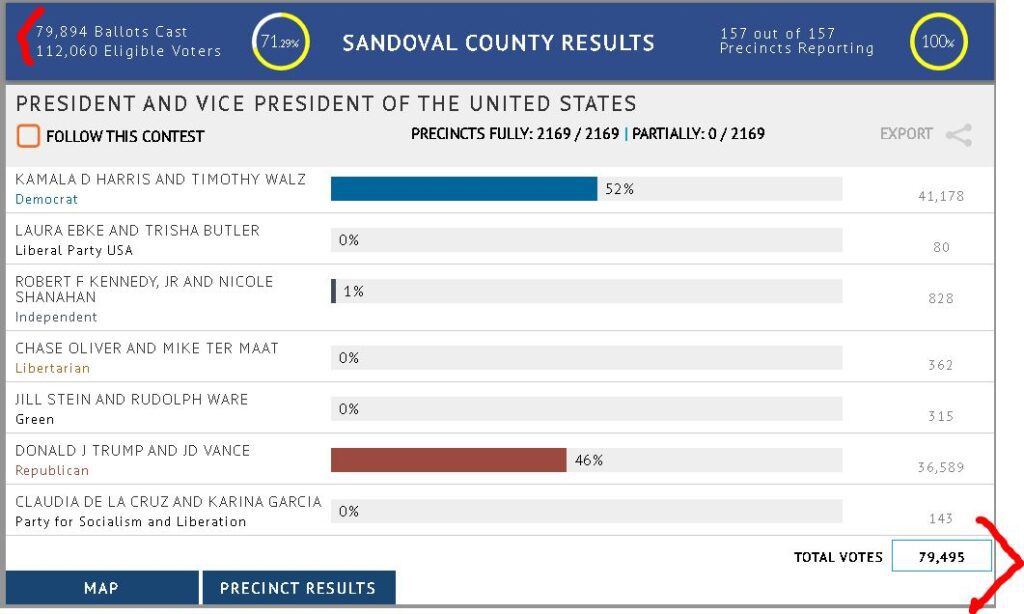As another election season concludes, New Mexicans are left with mixed emotions. Working as a clerk on November 5th, I witnessed the excitement on voters’ faces as they came in to cast their ballots. People lined up even before the polls opened at 7 a.m., and despite significant failures in the “same day registration” (SDR) system on Election Day, many stood in line for up to four hours without complaint. By the end of the evening, there was a palpable shift in the national landscape, and a sense of relief as voters felt unburdened by what had been.
While the national political climate appeared to moderate, New Mexico, in true fashion, seemed to lag behind. Recent articles in Estancia News on Doña Ana County and Election Night Reporting echo lingering concerns about New Mexico’s election system and those in charge of it.
A few weeks before Election Day, the Washington Post turned its spotlight on Sandoval County. Reporter Peter Jamison came to investigate what he referred to as election chaos in New Mexico. I invited him to return for the county canvass so he could witness the very “lore” he had dismissed—the significant systemic failures that characterize New Mexico’s elections.
On August 18, 2024, Sandoval County Commissioners were given a copy of the press release titled “CISA and FBI Release Joint PSA: Putting Potential DDoS Attacks During the 2024 Election Cycle in Context.” Articles regarding cybersecurity issues were also shared. Concerns about possible disruptions were evident even then.
Fast forward to Election Day: the Secretary of State admitted they were unprepared for the influx of voters needing to update addresses or register. Problems with the electronic poll books and the SDR system emerged as early as 7:50 a.m. when clerks discovered that addresses in the SDR system did not match those in the electronic poll books (e-pollbooks).
The Clerk’s Office notified poll workers that the SDR system would be taken down statewide from 9:15 to 9:30 a.m. However, the system in Sandoval County never fully recovered. At one point, Deputy Clerk Joey Dominguez reported more than 400 SDR issues in the queue for Sandoval County alone. The Secretary of State had to take the system offline twice that day, with the second outage lasting 30 minutes.
These system failures led to the casting of 427 provisional ballots in Sandoval County, of which 117 were disqualified due to a clerical error that resulted in envelopes being separated from ballots. In total, 316 provisional ballots were rejected, as noted in the Sandoval County canvass report.
During early voting, two spare tabulators were deployed without being properly certified. They lacked CF (CompactFlash) cards and seals, necessitating replacements. On Election Day, technical issues persisted. One instance was at Joe Harris Elementary, one tabulator did not function until after 9 a.m., when technicians intervened.
For the 2024 General election, workers were trained on a new process called “Operation Sunset,” intended to ensure that 75% of election results were uploaded by 9 p.m. This process required CF cards to be removed after printing tapes and shutting down the machines but before reconciling ballots with the tabulator count. These CF cards were then transported without proper chain-of-custody protocols.
Predictably, issues arose. One CF card from the Community of Joy Voting Convenience Center became corrupted, and its data was never uploaded, violating state statute NMSA 1-12-70 and rule NMAC 1.10.33.8(A). The discrepancy wasn’t discovered until the morning of November 15, 2024, when the Bureau of Elections was preparing for the canvass. As a result, Sandoval County did not report votes from one tabulator until November 15.
Discrepancies also surfaced between the total votes cast and precinct-level data. According to unofficial results from the Secretary of State, Sandoval County recorded 79,894 total votes, yet only 79,495 votes were cast in the presidential race—a shortfall of 399 votes. Did 399 people go to the polls and not vote for the President? An undervote/overvote report might explain this discrepancy, but none has been provided.

During the Board of Canvass, Deputy Clerk Joey Dominguez candidly admitted he had only provided the minimum documentation required by law due to the overwhelming post-election issues. His report to the Board provided transparency and integrity which stands in stark contrast to the actions of many elected officials today.
Commissioner Jay Block refused to certify the results, citing statutory violations. The other commissioners, however, certified the results without reviewing critical reports or logs. Commissioner Jones participated via Zoom and scrambled to review electronic files after the meeting had begun. What does this say about the integrity of the remaining commissioners? That is the question voters should be asking.
- Opinion | SB 218—New Mexico’s Promise Made, Promise Broken - February 24, 2025
- New Mexico’s Supreme Court Ignores Rights and Restricts Who Can Hear Election Cases - January 9, 2025
- Progressive Blueprint: How EMERGE’s Legislative Surge is Poised to Reshape New Mexico - January 6, 2025


